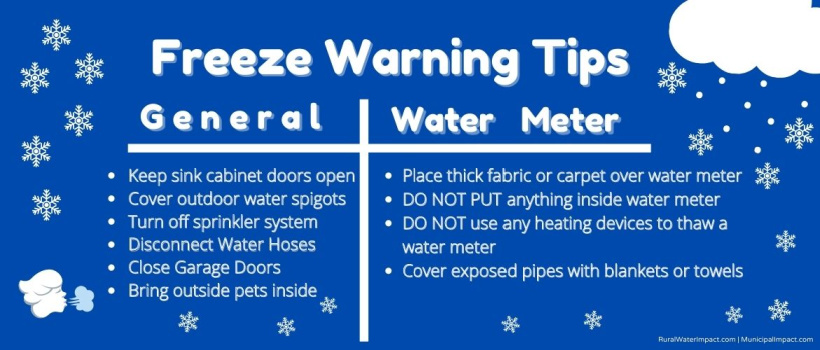Preparing Your Home for Freezing Tempratures
Inside
- Open the cabinets under the sinks in your kitchen and bathrooms to allow heated air to circulate around the water pipes.
- Set your thermostat at a minimum of 55 degrees, especially when you are gone for the day or away for a long time. 68 degrees is ideal for energy conservation.
- Let indoor faucets drip, but do not run a heavy stream of water (remember, it only takes a small drip).
Outside
- Protect faucets, outdoor pipes, and pipes in unheated areas with pipe insulation. In a pinch, wrapping them with rags, newspapers, trash bags, plastic foam or even bubble wrap can add needed protection.
- Cover any vents around your home’s foundation.
- Secure and close any gaps in underpinning of mobile homes.
- Drain water hoses and store them in a garage or shed.
- Drain irrigation water supply lines.
- Protect outdoor electrical pumps.
- Make sure you know where your main water shut-off valve is. Most homes have a master valve or a main water shut-off that will allow you to turn off all the water coming into the house. The video below can help you find the valve and learn how to shut it off safely.
- If you suspect you have a leak, turn the water off at the main shut-off valve.
- If you drain your pipes, do not forget to turn off the power to your water heater if it is electric and turn of the gas supply line the water heater if it is a gas appliance
How to Thaw Frozen Pipes
- If you turn on a faucet and only a trickle comes out, suspect a frozen pipe. Likely places for frozen pipes include against exterior walls or where your water service enters your home through the foundation.
- Keep the faucet open. As you treat the frozen pipe and the frozen area begins to melt, water will begin to flow through the frozen area. Running water through the pipe will help melt ice in the pipe.
- Apply heat to the section of pipe using an electric heating pad wrapped around the pipe, an electric hair dryer, a portable space heater (kept away from flammable materials), or by wrapping pipes with towels soaked in hot water. Do not use a blowtorch, kerosene or propane heater, charcoal stove, or other open flame device.
- Apply heat until full water pressure is restored. If you are unable to locate the frozen area, if the frozen area is not accessible, or if you can not thaw the pipe, call a licensed plumber.
- Check all other faucets in your home to find out if you have additional frozen pipes. If one pipe freezes, others may freeze, too.


 Freezing Temps
Freezing Temps